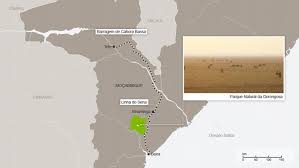GORONGOSA ANTI-POACHING
 The Anti-Poaching Unit of the Gorongosa National Park in central
Mozambique in 2014 seized about 180 homemade guns from local poachers, and
removed over 3,300 snares and traps. The Administrator of the park, Mateus
Mutemba, declared on Thursday, when signing an anti-poaching protocol with the
Portuguese Entreposto Group, that he is worried by the fact that an industry
manufacturing these lethal artefacts is still thriving in the area surrounding
the park. “Year after year we register growth in the number of poaching
incidents”, he said. “Last
year we arrested about 250 poachers. There is a recurrent trend to manufacture
these weapons and use them in poaching”.Unlike what is happening in the Niassa
Reserve in the far north, so far there is no record of military firearms being
used to decimate wild life in Gorongosa. “But we don’t make a great distinction
between weapons of war and home-made guns”, said Mutemba, “because they all
have the same purpose, which is to kill our animals, and to threaten the life
of our wardens while they are doing their job of protecting the Park”. Home-made guns could be very powerful, he noted.
Last year one of the locally manufactured firearms which Park wardens had
seized was powerful enough to bring down an elephant. In 2014, the park lost
three of its elephants to poachers.
The Anti-Poaching Unit of the Gorongosa National Park in central
Mozambique in 2014 seized about 180 homemade guns from local poachers, and
removed over 3,300 snares and traps. The Administrator of the park, Mateus
Mutemba, declared on Thursday, when signing an anti-poaching protocol with the
Portuguese Entreposto Group, that he is worried by the fact that an industry
manufacturing these lethal artefacts is still thriving in the area surrounding
the park. “Year after year we register growth in the number of poaching
incidents”, he said. “Last
year we arrested about 250 poachers. There is a recurrent trend to manufacture
these weapons and use them in poaching”.Unlike what is happening in the Niassa
Reserve in the far north, so far there is no record of military firearms being
used to decimate wild life in Gorongosa. “But we don’t make a great distinction
between weapons of war and home-made guns”, said Mutemba, “because they all
have the same purpose, which is to kill our animals, and to threaten the life
of our wardens while they are doing their job of protecting the Park”. Home-made guns could be very powerful, he noted.
Last year one of the locally manufactured firearms which Park wardens had
seized was powerful enough to bring down an elephant. In 2014, the park lost
three of its elephants to poachers.
 At the
ceremony, the Entreposto Group donated 125,000 US dollars to the Anti-Poaching
Unit. The protocol covers a five year period, with Entreposto disbursing 5,000
dollars per year.The aim of the protocol is to increase the effectiveness of
patrols, covering even the most remote areas in the park, and to ensure rapid
intervention in neutralising poachers. Other goals are to prevent illegal
logging within the park, to avoid conflict between wild animals and communities
(some of whom are still living inside the park boundaries), to step up the
detection and collection of snares, and to make communities aware of the
importance of preserving biodiversity.Entreposto Group director Jose Cardoso
said the company intended to make a long term contribution to the Anti-Poaching
Unit. Among the immediate uses of the money, he said, would be to acquire
a patrol boat that can operate on the lakes and waterways of the park, to
develop advanced and specialist training programmes for the wardens, and
provide them with uniforms, boots and walkie-talkie radios. With the
Entreposto money, Mutemba said, “we intend to improve our capacity to confront
the poachers. We have a force of 120 men who
are protecting the Park day and night. We need to step up their training and improve
the equipment they use”. This year, aerial patrols will also be
introduced, Mutemba added. The Park has acquired a light aircraft, giving it
the capacity to spot illegal activity from the air.The Gorongosa National Park
covers an area of about 4,000 square kilometres in Sofala province, and is
located at the southern end of the Great African Rift Valley.
At the
ceremony, the Entreposto Group donated 125,000 US dollars to the Anti-Poaching
Unit. The protocol covers a five year period, with Entreposto disbursing 5,000
dollars per year.The aim of the protocol is to increase the effectiveness of
patrols, covering even the most remote areas in the park, and to ensure rapid
intervention in neutralising poachers. Other goals are to prevent illegal
logging within the park, to avoid conflict between wild animals and communities
(some of whom are still living inside the park boundaries), to step up the
detection and collection of snares, and to make communities aware of the
importance of preserving biodiversity.Entreposto Group director Jose Cardoso
said the company intended to make a long term contribution to the Anti-Poaching
Unit. Among the immediate uses of the money, he said, would be to acquire
a patrol boat that can operate on the lakes and waterways of the park, to
develop advanced and specialist training programmes for the wardens, and
provide them with uniforms, boots and walkie-talkie radios. With the
Entreposto money, Mutemba said, “we intend to improve our capacity to confront
the poachers. We have a force of 120 men who
are protecting the Park day and night. We need to step up their training and improve
the equipment they use”. This year, aerial patrols will also be
introduced, Mutemba added. The Park has acquired a light aircraft, giving it
the capacity to spot illegal activity from the air.The Gorongosa National Park
covers an area of about 4,000 square kilometres in Sofala province, and is
located at the southern end of the Great African Rift Valley.
0 comentários:
Post a Comment